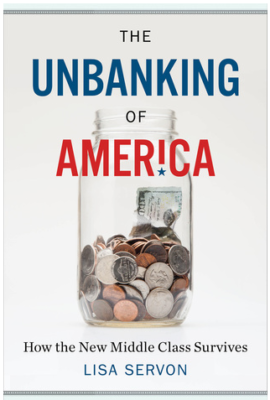The UnBanking of America – Lisa Servon

Driving home on Tuesday, I heard an interview on NPR with Lisa Servon, a professor of city and regional planning at the University of Pennsylvania. She was talking about her book and I was so impressed and intrigued that I stopped at Barnes & Noble to inquire if they had it. Ten copies had arrived that day and had not made it out to the Sociology section yet. One was brought to me from the storeroom.
If you only read one book this year, it should be this one. Most of us truly have no idea of how banking has changed since many of us opened our first bank accounts. Servon talks about how the industry as changed since she opened a pass book savings account in her hometown as a child in 1971:
“Banks like Pulaski still exist but have dwindled in number: very small banks (those with less than $100 million in assets) decreased by 85 percent between 1985 and 2013, while the number of very large banks (those with more than $10 billion in assets) nearly tripled. Local banking is now the exception rather than the norm . . .”
Servon had been doing research on consumer financial services when John Coleman, President of RiteCheck, was brought to one of her classes by Joy Cousminer, founder of Bethex Federal Credit Union. What she believed she knew about check cashing services and payday lenders was turned on its head by Coleman’s description of the community he served in the South Bronx and Harlem and why those services are needed. RiteCheck was founded in 1949 by his father-in-law Howard Stein, who at 92, still comes into work three days a week.
As Sevron describes it in her acknowledgements, “This book began with a question that turned into a quest. And, like all good quests, this one involved a journey, a series of vexing obstacles, a few riddles, and a terrific group of trusty sidekicks and wise elders.”
Understanding that quantitative data wasn’t telling the whole story of how the “unbanked” and “underbanked” used these “alternative financial resources,” she asked John Coleman if she could work as a teller for several months at RiteCheck to gather more qualitative data. Her research working at a branch location in the largely Latino community of Mott Haven relied on her co-workers’ deep understanding of the community and their long term relationships with their customers.
Following her work at RiteCheck, Coleman introduced her to Rob Zweig of Check Center in Oakland, CA, a payday lender. (Ritecheck does not make payday loans because they are illegal in New York.) Servon worked there for a short period of time followed by a month answering the Predatory Loan Help Hotline for the Virginia Poverty Law Center based in Richmond, VA.
“. . .unlike the debt collection work I did at Check Center, my time as a hotline operator was enormously satisfying. Much of the time, I could actually do something to help people. Callers were exceedingly grateful. But it was terrifically frustrating when I had no good news, no easy answers. Getting that close to the hopelessness of a person’s situation changed me.”
This book does a great deal to put a human face on what it means to try and make ends meet in this country, today, in 2017. Her chapter about Millennials is entitled “Living in the Minus.”
“I was surprised to learn how many millennials had used alternative financial services like payday lenders, check cashers, prepaid debit cards, and pawnshops. Like the ‘new nonprime’ folks who have relatively high incomes and own their homes, my millennial interviewees don’t fit the stereotype of the alternative financial services user.”
The strength of the book is in the storytelling. Yes, there is excellent quantitative and qualitative research and analysis. The statistics are arresting, the history of bank regulation is an eye-opener, and her interviews with FinTech entrepreneurs is fascinating. But it’s the conversations with her co-workers, with the people she meets along the way in researching and writing this book that strike a chord.
How is it okay for an entire industry to leave so many people with so few options? When did it become about profits over people? What was the banking industry designed to do and who is it designed to serve?
“A recent study conducted by the Center for Financial Services Innovation found that 57 percent of Americans – 138 million people – are struggling financially, more than double the number of adults the FDIC categorized as unbanked or underbanked in its most recent survey.”
Servon does a masterful job in shining a light on this incredibly important subject. It’s a bonus that the book is so well written. At less than 200 pages, it’s easy to dive in and get to the other side. I highly recommend it!